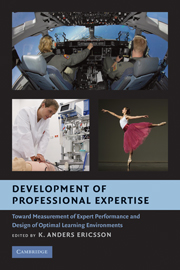 Development of Professional Expertise
Development of Professional Expertise Book contents
- Frontmatter
- Contents
- List of Figures
- List of Tables
- List of Contributors
- 1 The Measurement and Development of Professional Performance: An Introduction to the Topic and a Background to the Design and Origin of This Book
- SECTION 1 CHALLENGES IN PAST AND CONTEMPORARY EFFORTS TO MEASURE AND TRAIN THE OBJECTIVE PERFORMANCE OF PROFESSIONALS
- SECTION 2 PAST AND CONTEMPORARY EFFORTS TO DESIGN INSTRUCTION, TRAIN, AND MAINTAIN PROFESSIONAL PERFORMANCE
- SECTION 3 THE ASSESSMENT AND TRAINING OF SKILLED AND EXPERT PERFORMERS IN THE MILITARY
- 10 Toward a Second Training Revolution: Promise and Pitfalls of Digital Experiential Learning
- 11 Evaluating Pilot Performance
- 12 Contrasting Submarine Specialty Training: Sonar and Fire Control
- 13 Training Complex Cognitive Skills: A Theme-Based Approach to the Development of Battlefield Skills
- 14 Structuring the Conditions of Training to Achieve Elite Performance: Reflections on Elite Training Programs and Related Themes in Chapters 10–13
- SECTION 4 THE DEVELOPMENT OF EXPERTISE AND EXPERT PERFORMANCE
- Name Index
- Subject Index
- References
10 - Toward a Second Training Revolution: Promise and Pitfalls of Digital Experiential Learning
Published online by Cambridge University Press: 04 August 2010
- Frontmatter
- Contents
- List of Figures
- List of Tables
- List of Contributors
- 1 The Measurement and Development of Professional Performance: An Introduction to the Topic and a Background to the Design and Origin of This Book
- SECTION 1 CHALLENGES IN PAST AND CONTEMPORARY EFFORTS TO MEASURE AND TRAIN THE OBJECTIVE PERFORMANCE OF PROFESSIONALS
- SECTION 2 PAST AND CONTEMPORARY EFFORTS TO DESIGN INSTRUCTION, TRAIN, AND MAINTAIN PROFESSIONAL PERFORMANCE
- SECTION 3 THE ASSESSMENT AND TRAINING OF SKILLED AND EXPERT PERFORMERS IN THE MILITARY
- 10 Toward a Second Training Revolution: Promise and Pitfalls of Digital Experiential Learning
- 11 Evaluating Pilot Performance
- 12 Contrasting Submarine Specialty Training: Sonar and Fire Control
- 13 Training Complex Cognitive Skills: A Theme-Based Approach to the Development of Battlefield Skills
- 14 Structuring the Conditions of Training to Achieve Elite Performance: Reflections on Elite Training Programs and Related Themes in Chapters 10–13
- SECTION 4 THE DEVELOPMENT OF EXPERTISE AND EXPERT PERFORMANCE
- Name Index
- Subject Index
- References
Summary
I begin, in the time-honored military lecture way, by telling you what I intend to tell you:
Early results with language, convoy operations, and information technology troubleshooting suggest that, at their best, lightweight digital simulations can train superbly. However, the notion of training delivered on personal computers also gives rise, apparently by spontaneous generation, to a horde of ‘games for training’ fanatics whose products ensure that, at the median, such simulations are dreadful. Even the best of breed suffer because training individuals to perform as part of a larger military unit often forces the rest of the team and other echelons, above and below, to become expensive and difficult-to-schedule training devices. Moreover, current military operations require soldiers to spend most of their time doing exactly what they did not join the military to do: deal with very sticky situations involving human and cultural interactions. A successful second training revolution must deal with these new missions. To do so simulations will need ‘people engines’ to control characters in virtual cultural landscapes in the same way ‘physics engines’ control physical simulation objects. A handful of plausibility arguments suggest that this might be doable, but there are few existence proofs. Finally, and always, whatever we create will fail if training is not embedded from the beginning.
THE FIRST TRAINING REVOLUTION DOES NOT SCALE
In Chapter 2, I discussed a revolution in military training.
- Type
- Chapter
- Information
- Development of Professional ExpertiseToward Measurement of Expert Performance and Design of Optimal Learning Environments, pp. 215 - 246Publisher: Cambridge University PressPrint publication year: 2009
References
- 5
- Cited by
